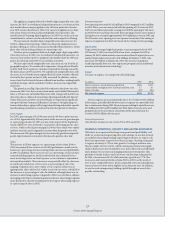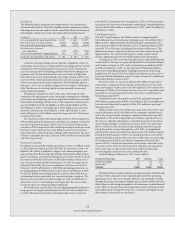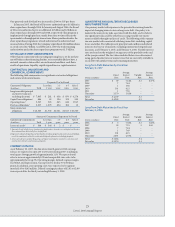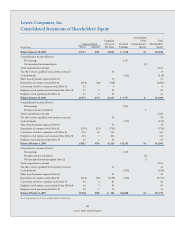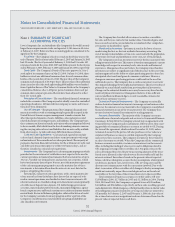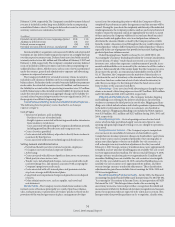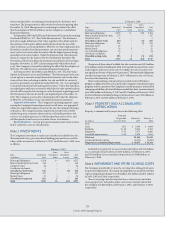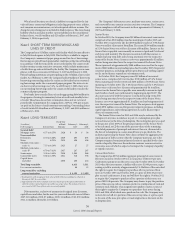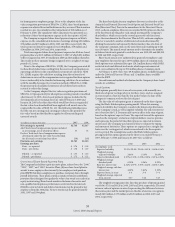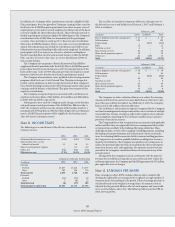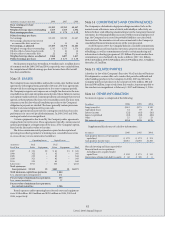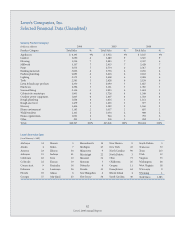Lowe's 2006 Annual Report Download - page 37
Download and view the complete annual report
Please find page 37 of the 2006 Lowe's annual report below. You can navigate through the pages in the report by either clicking on the pages listed below, or by using the keyword search tool below to find specific information within the annual report.
33
Lowe’s 2006 Annual Report
Sales generated through the Company’s proprietary credit cards are
not reected in receivables. Under an agreement with GE, credit is extended
directly to customers by GE. All credit program-related services are per-
formed and controlled directly by GE. e Company has the option, but
no obligation, to purchase the receivables at the end of the agreement in
December 2016. Tender costs, including amounts associated with accept-
ing the Company’s proprietary credit cards, are recorded in SG&A in the
consolidated nancial statements.
e total portfolio of receivables held by GE, including both receivables
originated by GE from the Company’s private label credit cards and
commercial business accounts receivable originated by the Company and
sold to GE, approximated $6.0 billion at February 2, 2007, and $5.0 billion
at February 3, 2006.
Property and Depreciation – Property is recorded at cost. Costs
associated with major additions are capitalized and depreciated. Capital
assets are expected to yield future benets and have useful lives which
exceed one year. e total cost of a capital asset generally includes all
applicable sales taxes, delivery costs, installation costs and other appro-
priate costs incurred by the Company in the case of self-constructed
assets. Upon disposal, the cost of properties and related accumulated
depreciation are removed from the accounts, with gains and losses
reected in SG&A expense in the consolidated statements of earnings.
Depreciation is provided over the estimated useful lives of the
depreciable assets. Assets are depreciated using the straight-line method.
Leasehold improvements are depreciated over the shorter of their estimated
useful lives or the term of the related lease, which may include one or more
option renewal periods where failure to exercise such options would result
in an economic penalty in such amount that renewal appears, at the
inception of the lease, to be reasonably assured. During the term of a lease,
if a substantial additional investment is made in a leased location, the
Company reevaluates its denition of lease term to determine whether the
investment, together with any penalties related to non-renewal, would
constitute an economic penalty in such amount that renewal appears, at
the time of the reevaluation, to be reasonably assured.
Long-Lived Assets/Store Closing – Losses related to impairment of
long-lived assets are recognized when circumstances indicate the carrying
values of the assets may not be recoverable. When management commits
to close or relocate a store location, or when there are indicators that the
carrying value of a long-lived asset may not be recoverable, the Company
evaluates the carrying value of the asset in relation to its expected undis-
counted future cash ows. If the carrying value of the assets is greater than
the expected undiscounted future cash ows, and the fair value of the assets
is less than the carrying value, a provision is made for the impairment of
the assets based on the excess of carrying value over fair value. e fair
value of the assets is generally based on appraisals and the Company’s
historical experience.
When a leased location is closed, a provision is made for the present
value of future lease obligations, including property taxes, utilities, and
common area maintenance, net of anticipated sublease income. Provisions
for impairment and store closing costs are included in SG&A expense.
e store closing liability is included in other current liabilities in the
consolidated balance sheets.
Leases – For lease agreements that provide for escalating rent payments
or free-rent occupancy periods, the Company recognizes rent expense
on a straight-line basis over the non-cancelable lease term and option
renewal periods where failure to exercise such options would result in an
economic penalty in such amount that renewal appears, at the inception
of the lease, to be reasonably assured. e lease term commences on the
date that the Company takes possession of or controls the physical use of
the property. Deferred rent is included in other long-term liabilities in
the consolidated balance sheets.
Assets under capital leases are amortized in accordance with the
Company’s normal depreciation policy for owned assets or, if shorter,
over the non-cancelable lease term and any option renewal period where
failure to exercise such option would result in an economic penalty in
such amount that renewal appears, at the inception of the lease, to be
reasonably assured. e amortization of the assets is included in depre-
ciation expense in the consolidated nancial statements. During the
term of a lease, if a substantial additional investment is made in a leased
location, the Company reevaluates its denition of lease term.
Self-Insurance – e Company is self-insured for certain losses relating
to workers’ compensation, automobile, property, and general and product
liability claims. e Company has stop-loss coverage to limit the exposure
arising from these claims. e Company is also self-insured for certain
losses relating to medical and dental claims. Self-insurance claims led and
claims incurred but not reported are accrued based upon management’s
estimates of the discounted ultimate cost for uninsured claims incurred
using actuarial assumptions followed in the insurance industry and historical
experience. Although management believes it has the ability to adequately
record estimated losses related to claims, it is possible that actual results
could dier from recorded self-insurance liabilities.
Income Taxes – e Company establishes deferred income tax assets
and liabilities for temporary dierences between the tax and nancial
accounting bases of assets and liabilities. e tax eects of such dierences
are reected in the balance sheet at the enacted tax rates expected to be
in eect when the dierences reverse. A valuation allowance is recorded
to reduce the carrying amount of deferred tax assets if it is more likely
than not that all or a portion of the asset will not be realized. e tax bal-
ances and income tax expense recognized by the Company are based on
management’s interpretation of the tax statutes of multiple jurisdictions.
e Company includes interest related to tax issues as part of net interest
in the consolidated nancial statements. e Company records any appli-
cable penalties related to tax issues within the income tax provision.
Revenue Recognition – e Company recognizes revenues, net of
sales tax, when sales transactions occur and customers take possession
of the merchandise. A provision for anticipated merchandise returns is
provided through a reduction of sales and cost of sales in the period that
the related sales are recorded. Revenues from product installation services
are recognized when the installation is completed. Deferred revenues
associated with amounts received for which customers have not yet taken
possession of merchandise or for which installation has not yet been
completed were $364 million and $377 million at February 2, 2007, and
February 3, 2006, respectively.
Revenues from stored value cards, which include gi cards and returned
merchandise credits, are deferred and recognized when the cards are
redeemed. e liability associated with outstanding stored value cards
was $367 million and $293 million at February 2, 2007, and February 3,
2006, respectively, and these amounts are included in deferred revenue
in the accompanying consolidated balance sheets. e Company recog-
nizes income from unredeemed stored value cards at the point at which
redemption becomes remote. e Company’s stored value cards have no
expiration. erefore, to determine when redemption is remote, the
Company analyzes an aging of the unredeemed cards, based on the date
of last stored value card use.
Extended Warranties – Lowe’s sells separately-priced extended
warranty contracts under a Lowe’s-branded program for which the
Company is ultimately self-insured. e Company recognizes revenue
from extended warranty sales on a straight-line basis over the respective
contract term. Extended warranty contract terms primarily range from
one to four years from the date of purchase or the end of the manufacturer’s
warranty, as applicable. Deferred revenues related to the Company’s extended
warranty sales were $315 million and $206 million at February 2, 2007 and


